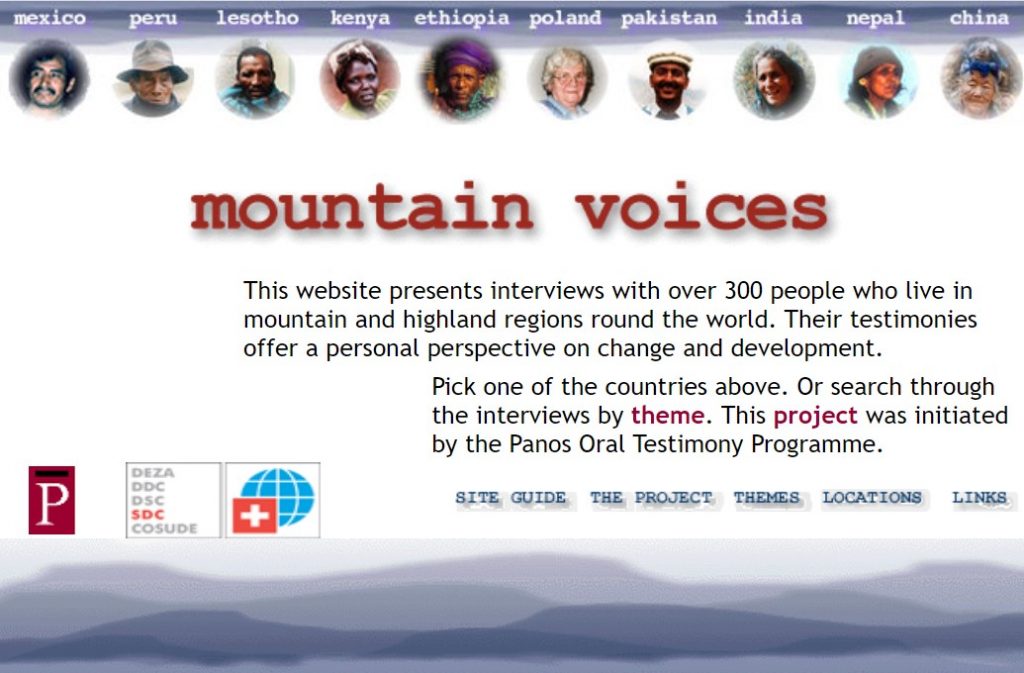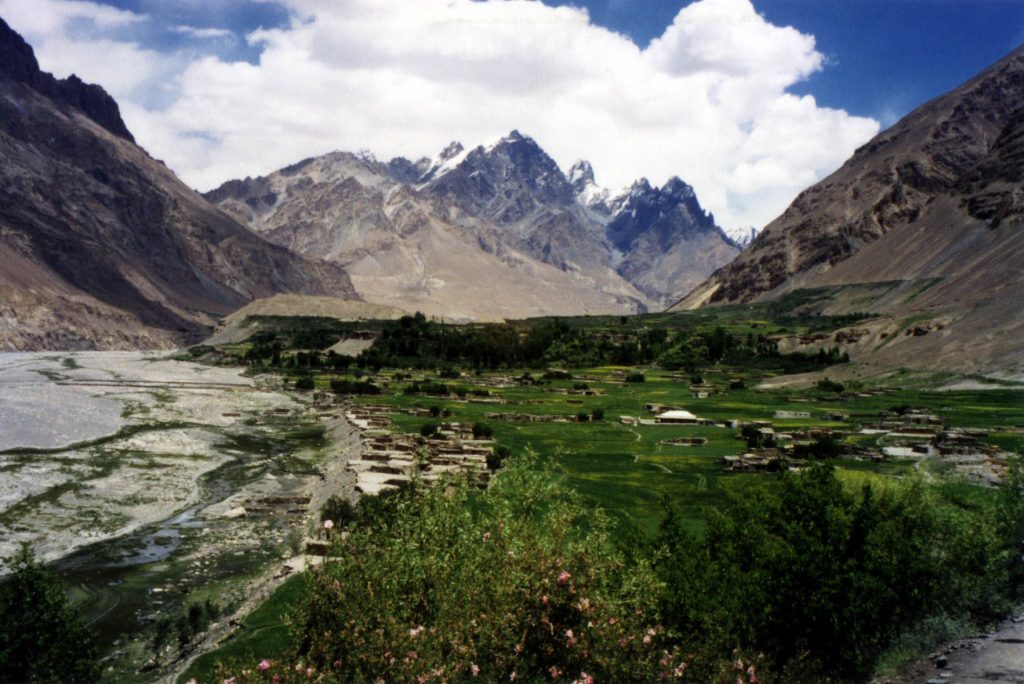Re-visiting environmental oral histories recorded over 20 years ago
As COP26 gets underway Siobhan Warrington who currently is working on the Living Deltas Hub, revisits a collection of oral histories recorded over 20 years ago with women and men living in mountain and highland regions around the world.
“The timing has gone wrong,” stated Yagjung, a 59-year-old female weaver from Uttarkhand, India, interviewed in December 1996. She was referring to the weather, to the timing of the rain and the harvests, but the idea that ‘the timing has gone wrong’ has wider relevance. Campaigners and journalists talk about climate change ‘happening now’ but for Yagjung and other mountain farmers around the world, the ‘now’ of environmental degradation and climatic changes, was 25 years ago.
Like many others, I’m thinking about COP26 with a mixture of optimism and dread. My Twitter and Instagram accounts and work TEAMS channel are full of relevant articles and initiatives. In the last week, I have attended a webinar on climate justice and development by Professor Chukwumerije Okereke; I re-posted Mikaela Loach’s Instagram post on movements being not just about those who are visible; I read and shared a great news article on climate debt by Mohamed Adow; I listened to Dr Camelia Dewan introduce her book Misreading the Bengal Delta; and around the edges I’ve been reading transcripts of interviews with women and men living in a rural area of the Mekong delta in Vietnam.
Yesterday I found myself thinking about www.mountainvoices.org an international collection of some 300 interviews with women and men living in mountain regions, recorded between 1994 and 2000[1] and the related idea that climate change is about the past, present and future. And so today I’ve been looking at those interviews and I found plenty of links to the issues raised by the individuals cited above: injustice, harmful development initiatives, environmental degradation, histories of colonial exploitation, and multiple voices sharing their knowledge of and respect for the natural world.

Revisiting these first-hand accounts of women and men living in mountain areas, recorded 20-25 years ago, I am struck by the sheer volume of accounts conveying knowledge of and intimacy with their mountain environments. From Peru and Mexico to Poland and India expressions of connection with, and deep respect for, the natural world abound; there is an intelligence of sustainability that is rooted in heritage and lived experience; an understanding of ecosystems, mutual dependence and the importance of biodiversity. The term ‘lived experience’ doesn’t adequately convey knowledge that centres on justice and sustainability, I’m wondering whether ‘environmental intelligence’ would be more appropriate.
Injustice and exploitation are key themes across these oral testimonies. Much of the degradation experienced by those living in mountain areas is caused by external agencies: mining in Peru and Jamaica; [2] dam-building in Lesotho; commercial deforestation in India and China; roadbuilding in India and Nepal; industrial pollution in Peru and Poland. Many mountain communities have suffered from the environmental injustice of planned ‘development’ efforts, with narrators in Peru and India tracing this back to destruction and exploitation by colonial powers. While there are references to the community members in Mexico and Ethiopia being responsible for degradation – namely through deforestation; their over-use of natural resources is borne out of poverty, as opposed to seeking commercial profit or economic development goals.
One thing is clear, decisions about the environment cannot be made without the participation of those whose lives directly depend on it; without their intimate connection and knowledge, there is a risk that decisions and actions will lack the urgency and justice that is required now. The participation of those most affected is critical in COP26; to cut through the blah blah and embed a true urgency and demand for justice into proceedings and decisions.
For many of us, our geographical, racial, and economic privileges, have allowed us to understand the climate crisis as happening in times and places beyond ourselves. Recent catastrophic fires and floods in many parts of the world including Europe, Australia and North America, means that more of us understand the climate crisis as something that is here and now. The Mountain Voices testimonies remind us that for many people environmental degradation has been ‘here’ and ‘now’ for decades. I’ve shared some short extracts below, with links to the full transcripts.
Environmental degradation and exploitation
We’re anxious to reclaim our territory… You asked about the changes that have occurred in the community, well – this is a historical change. Meaning that forever, since the arrival of the Spanish, since the arrival of the Gringos and their huge mining companies, my community, our communities, have continually lost their land, whether it be through pillage or expropriation.
Hector, male, 33 years, teacher, Cerro de Pasco, Peru (1995)
The hillsides of the mountain range were pure pasture, so we were able to keep cattle and also plant crops…. But if you look around now… there’s no land to be seen – there’s a mountain there, but it’s a mountain of pure rubbish from the mine.
Ignacio, male, 71 years, electrician, Cerro de Pasco, Peru (1995)
In the middle of the twentieth century, a new danger to the mountain forest appeared. It was caused by an inflow of polluted air from the south. A new generation of brown coal-fired power works, which had been established in northern Czech Republic, emitted large quantities of sulphur. That led to the dying-out of trees.
Kazimierz, male, 45 years, forester, Kłodzko Valley, Poland (1999)
Only 15% forest remains here. [deforestation] began with the construction of the roads and the advent of development [3]… forests give fresh air, water and many other necessary things to us. Now the people are facing the problems of drought, scarcity of water and environmental pollution.
Mohan, male, 60 years, ayurvedic physician, Garwhal and Kinnaur, India (1994)
In our place, when we were young, trees were everywhere. They were so many that you couldn’t get through them… I went [home] twice this year. I felt such sorrow when I saw the mountains. It was as though they had been cut by a sickle, not one tall tree left…People are rich, but the resources are used up.
Xuefeng, female, 40 years, doctor, Yunnan, China (1997)
Changes in weather patterns remembered
Earlier it used to snow in December, in Dunda as well as at Harsil. But this year in December the rains have not even started in Harsil. When we sow the seeds, it does not rain. The timing has gone wrong. It rains at the time of harvest, which causes great loss.
Yagjung, female, 59 years, weaver, Garwhal and Kinnaur, India (1996)
Even when it rains on time and the crop grows, the rain comes again and destroys it.
Ayichesh, female, 28 years, head of household, North Wollo, Ethiopia (1996)
The rainfalls are much heavier; they often result in floods. On the other hand, there are droughts and extremely high temperatures. The contrasts are something new in our climate…. I don’t remember such changing weather in my childhood. It is caused mainly by man’s activity.
Tadeusz, male, 43 years, farmer, Kłodzko Valley, Poland (1999)
An environmental intelligence of rich proportions: knowledge and respect
We respected the forest because we understood that it attracted the rainfall. Sabaot also loved honey and we collected honey from our Mwengeshok that we put in the forest. We were also hunters and the wildlife in the forest was also a source of meat. Another important thing is that the forest provided us with herbal medicine…this made it imperative for everyone to think of preserving the forest. Anybody cutting down trees unnecessarily would be admonished by the community.
Samuel, male, 90 years, Mount Elgon, Kenya (1996)
My grandfather was a beekeeper, my father was a beekeeper, and I’ve been a beekeeper since my childhood… Here, a beekeeper waits for the honey to be good, and only then the honey is collected.
Wladyslaw, male, 72 years, pensioner/beekeeper, Kłodzko Valley, Poland (1999)
Traditionally hunting in the breeding season was completely banned. The person who would hunt, by mistake, a female or pregnant animal were disliked and admonished by the community and sometimes socially boycotted (by rejecting the meat of the game). It was acceptable to hunt the old animals, it was an established system. They had made the hunting practices and the wildlife part of their culture… For example, they would express [their attachment to the wildlife] in their folk songs and cultural events as a means of reminding the people…about the ethics of hunting and reiterating their attachment to their environment.
Johar, male, 43 years, engineer, Shimshal, Pakistan (2002)
The water of a banjh (oak) and buranjh (rhododendron) forest is very cool… These trees are good. How can we get water without these trees? Trees are very necessary for retaining water of the soil. The manure of these leaves is superior to the government (chemical) manure.
Attar, female, 60 years, midwife/farmer, Garwhal and Kinnaur India 11 (1993)
It’s because we cut down trees, that’s why we’re lacking water. I think that it’s because of the deforestation that the rain has left us. Before, when I was still a boy, well, there was a mist in the mountains almost all year but now it doesn’t rain anymore… in my way of thinking we are finishing ourselves off by killing the forest.
Cecilio, male, 42 years, farmer, Oaxaca, Mexico (1999)
The things that are going to be lost [when we are resettled] are many, the wisdom of living in that area will be lost to you… Things like [wild] vegetables which we are now used to, and we know their places, where they grow, and also those things like the same medicines.
Sebili, male, 46 years, farmer, the Maluti mountains, Lesotho (1997)
… nature can defend itself up to a certain point, but when it is crossed – it can’t anymore.
Krzysztof, male, 60 years, Scientist, Poland 22 (1999)
Looking ahead

We all think that the Shimshal Nature Trust is not a new thing or an innovation. It is a bridge between inside and outside the village. It is just putting into writing the local traditional practices. It is just taking the indigenous experiences to the modern people…we realised that the indigenous wisdom and practices are… more environmentally sensitive… We think it is more important to understand the people’s feeling of their surrounding than articulating regulations and imposing restrictions.
Muzaffer, male, 32 years, development professional, Shimshal, Pakistan (2000)
There is much more dryness in a pine forest. And other trees and plants don’t grow there. But where you find oak and rhododendron, you will find dampness, moisture. I believe we should uproot the young plants of pine… And we should propagate the useful plants so that they can give seeds. My experience is that naturally grown plants are better for forests instead of the plantation species.
Savitri, female, 50 years, Buddhist, head of rural women’s council, Garwhal and Kinnaur, India 29 (1994)
Seeing us working on the hills everyday, our neighbours said, “The couple must be out of their minds, how can trees grow on such rocky hills?” They still thought I was doing something wrong. Last year all the 100 plum trees we planted blossomed. It looked like white clouds on the hills. Not until then did the villagers begin to realise that we are doing promising work. Now they look at us with envious eyes.
Fengying, female, 40 years, village head, Hebei, China 30 (1997)
Until we link the environment with development, we cannot talk of the right kind of development.
Jagat, male, 44, years, self-taught forester and farmer, Garwhal and Kinnaur, India (1994)
[1] The interviews were recorded as part of a joint initiative between UK-based NGO Panos London, and in-country NGOs and community groups. The full transcripts of the interviews, summaries and thematic analysis are available on www.mountainvoices.org.,
[2] Following the Mountain Voices project, Panos and its partners recorded oral testimonies with a mine-affected mountain community in Jamaica.
[3] Commercial exploitation of the forests by the British colonial authorities and the princely states began in the mid-nineteenth century. Great swaths of oak and cedar were felled. Ownership and control of community forests were taken over by the state, and the wide variety of local trees was replaced by single species, often pine (source www.mountainvoices.org)
